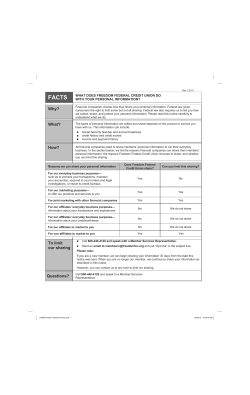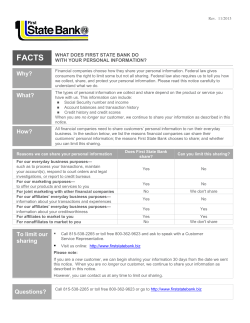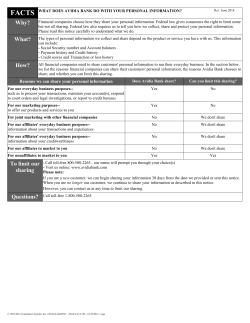
Assessing and Addressing the Training Needs of Medical
Assessing and Addressing the Training Needs of Medical Information Professionals Worldwide Caitlin Lentz, PharmD1; Christie Celli, RN, BSN2; Thomas Faria, PharmD, M.Sc.2; John Berg, PharmD, RPh2 1. Rutgers Pharmaceutical Industry Fellowship 2. Celgene Corporation Methods continued There are a variety of sizes, operating procedures, and even names for Medical Information (MI) departments within pharmaceutical companies; however, they share one common goal: to respond to healthcare professionals (HCPs) and consumer’s medical inquiries regarding the companies’ products. There is evidence which suggests the training and continuing development programs for MI professionals globally are not standardized both for individuals within our company and across the biopharmaceutical industry. Several studies were reviewed regarding the training process of MI professionals in the United States (US) and Europe. One survey found that the majority of individuals (67 %) felt that the training process could be improved, to which they suggested standardized, continuous, and up-to-date training.1 The same survey found 10/18 companies offer “ongoing refresher” training, which is defined as post-onboarding or continuous periodic training after the MI specialist has completed initial onboarding. None of the companies offer consistently scheduled post-onboarding training, and only 30% of companies require a knowledge assessment after the training. In another survey, investigators found 32% of MI professionals considered professional skills (project management, working with others, etc) as their most important training need to perform their MI role.2 These studies confirmed the need for continuous MI specific trainings, as well as onboarding training. The Global MI department at Celgene, based in the US, began in 1997 with 2 people and quickly grew to its current team of 26. In addition to the growth within the Global MI team, Celgene has also expanded at the local level requiring MI professionals in over 20 countries. Based on this rapid growth, we have discovered a need to assess our current state of training at the global, regional, and local levels. As part of an overall process enhancement effort, our team has undertaken an external benchmarking study and internal needs analysis to investigate MI training and professional development and provide insight regarding ways to enhance the global standard. The Celgene survey was used to assess the current global standard of training for MI at Celgene. Additionally, 21 out of the 23 MI affiliates who had completed the online Celgene MI survey were interviewed via teleconference in order to obtain more in-depth information and insights. All graphs were created through Microsoft Excel and descriptive statistics were used to draw conclusions. Objectives •Gain an understanding of the landscape of MI training experiences within Celgene and at other pharmaceutical companies. •Identify gaps in training within Celgene MI. •Make recommendations to standardize and enhance current training practices for the Celgene MI team in the US and globally. Methods Non-Celgene MI 0% 20% 40% 60% 80% Therapeutic area learning modules Medical Information Core Functions US Industry Professionals External Survey (n=64) 100% Figure 4. What kind of post-onboarding training is offered in your MI department? 83% 80% Celgene MI 60% 50% 57% Non-Celgene and Celgene Survey Results •The response rate by question for the online non-Celgene survey ranged from 31-41 % (26/64) and for the online Celgene survey was 100% (23/23). After the results from the online Celgene survey were gathered, 21/23 MI affiliates were available to be interviewed via teleconference. •Both online surveys revealed the majority of MI professionals provide verbal responses to internal and external customers, write medical response documents, and conduct literature searches/evaluate literature as their core responsibilities. However, there were large variations in the percentages of Celgene MI professionals reviewing medical response documents and promotional review of marketing materials vs. non-Celgene MI professionals. Other responsibilities for Celgene included functions outside of MI, such as drug safety, medical education, marketing, and MSL roles (Figure 2). Figure 2. What are the core responsibilities in your MI department? 10.0% 20.0% 30.0% 40.0% 50.0% 60.0% 70.0% 80.0% 90.0% 88.5% 65.2% 88.5% 34.8% Seach/evaluate literature 88.5% 78.3% Provide verbal responses 84.6% 82.6% Promotional Review 84.6% 56.5% 61.5% 60.9% 57.7% MI support of regulatory activities Other 43.5% 11.5% 47.8% Non-Celgene (N=26) 40.9% 40% 30% 27.3% 22.7% 100% 30% Celgene (N=23) Celgene (n=22) 35% 40% 35% 20% 94% Tools/technology training Results Reviewing materials for external use 45.5% 45.5% 45% 50% 61% 26% 10% 4.5% 5% 4.5% 0.0% 0% 11% 22% Non-Celgene (N=18) Write response documents NonCelgene (n=20) 65% 9.1% Other 0.0% 75% 70% 0 Shadowing US + Global Affiliates Internal Survey (N=23) •1:1 Interviews (n=20) 75% 89% 65% 30% • • • Discussion 70% Live presentations Review response documents The current processes and resources associated with the different stages of training (onboarding and post-onboarding) in MI departments at other pharmaceutical companies and at Celgene worldwide were evaluated via two online Survey Monkey® surveys (figure 1). One 12-question online survey was disseminated to 64 US-based MI professionals industry-wide across 29 different companies (Celgene excluded), in order to establish the current standard for MI training. A separate six-question online survey was disseminated to 23 MI affiliates representing 22 different countries (or groups of countries) within Celgene. These countries included: Switzerland, Australia, Canada, China, Russia, Korea, Slovenia, Austria, Belgium/Luxemburg, France, Germany, Hungary, Italy, The Netherlands, Nordics, Poland, Portugal, Slovakia, Spain, Turkey, UK/Ireland, and the US. Figure 3. What training materials do you have to provide to new hires and employees? Product learning modules Figure 1. Study Design • • Results continued Results continued Introduction Celgene (N=23) •80.8% of non-Celgene (N=26) and 17.4% of Celgene (N=23) MI professionals who took the respective online surveys reported having a formal training schedule/process in place in their MI department. There was geographic variability in the responses received by the Celgene and non-Celgene MI staff. The non-Celgene individuals who completed the survey were all US-based, however, only 1/23 individuals who completed the Celgene survey was US-based. In addition, after speaking with the majority of the selected affiliates, many joined the MI department several years ago and continue to be the sole MI professional for Celgene in their country or region. This discovery relieves many of the need for a formal onboarding schedule since there have not been any new hires. •Out of the 80.8% of non-Celgene MI professionals who have a formal training schedule/process in place in their MI department: oThere were 50% who stated their training process takes 1-3 months and 33.3% stated it takes less than 1 month to complete. oThere were 94.4% who stated they receive hands-on training from a trainer, manager, or mentor. In addition, 77.8% and 50% receive training from web-based or printed documents, respectively. •Half of the non-Celgene MI professionals (n=22) have an individual dedicated to facilitating or providing training and developing training materials at their company’s MI department. •More than half of non-Celgene MI professionals (52.4%) stated they update their training materials between every 6 months to 1 year. Only 4.8% responded that they update their training materials more often than every 6 months and the remainder of respondents update their materials periodically or less often than annually. Interviews with Celgene MI Affiliates •11/20 (55%) of affiliates interviewed had additional roles besides MI, such as drug safety, marketing, IITs, publications, RML, and medical education. •15/20 (75%) of affiliates interviewed had MI experience prior to their employment at Celgene. •The number of MI inquiries each country receives monthly ranged from 21100. •14/20 (70%) of the affiliates interviewed collaborate with other countries for training materials. •If affiliates are in need of additional professional development trainings, they refer to their manager, the Regional MI office, or contact an external program to conduct training. Figure 5. What are the most common training needs for Celgene Global Medical Information? 0% 5% 40% 35% Communication skills Literature searching/evaluation 30% Technology resources 30% Disease state/Product Limitations •Open-ended questions •External surveys disseminated to multiple people at certain companies vs 1 person at 1 company •Only used descriptive statistics •Low and varied response rates for each non-Celgene survey question •Small survey populations •Language barrier Conclusion 10% 15% 20% 25% 30% 35% 40% Centralized guide to training resources Biostatistics The non-Celgene survey indicated the industry standard for MI professionals’ main core responsibilities include writing/reviewing response documents and searching/evaluating literature. The most common trainings that are provided to new hires at non-Celgene companies include shadowing, tools/technology training, and therapeutic area/product learning modules. In addition, the majority of companies assessed have a formal training schedule or process in place for their MI departments and update their materials between every six months to one year. Compared to other post-onboarding resources that are offered, the percentages of MI professionals that receive literature searching and evaluation training is much lower than other trainings. This can be considered a gap in training since literature searching and evaluating is one of the top core responsibilities for MI. There was alignment in training professionals to search and evaluate literature in order to be able to write response documents. All companies prepare to do this through mainly product and disease state training in less than three months. Despite the rapid growth of its MI department, Celgene exceeds the industry norm by providing training materials in the MI core functions and also has a trainer dedicated to US MI department. Interestingly, Celgene and non-Celgene MI professionals share the same top three post-onboarding training opportunities: communication, product education, and disease state knowledge. The common training needs for Celgene Global MI were consistent with their common core responsibilities, providing verbal responses, searching/evaluating literature, and writing response documents. As a result, this aligned with their most common training needs: communication skills, literature searching/evaluation, technology resources (Celgene equivalent of Pubmed), disease state/product education, and biostatistics. The responses of to the Celgene and non-Celgene surveys identified training gaps in literature searching and evaluation resources, even though those functions are the main core responsibilities of MI. The global standard for MI training resources and processes should be continuous, updated at least annually, and centralized. We plan on implementing changes to our global MI training program based on the results of this study. Disclosures Caitlin Lentz: nothing to disclose Christie Celli: Celgene shareholder Thomas Faria: Celgene shareholder 15% References 1. 15% n=20 2. Jaisinghani J and Patel S. Training new-hire medical information specialists in the pharmaceutical industry: A benchmarking survey. DIJ 2013; 47(3): 356-362. Leighton S and Davies JE. Surveying medical information across Europe: the present and the future. DIJ 2009; 43: 637. Poster presented at the DIA Medical and Scientific Communications 2014 Annual Forum in Orlando, FL
© Copyright 2025









